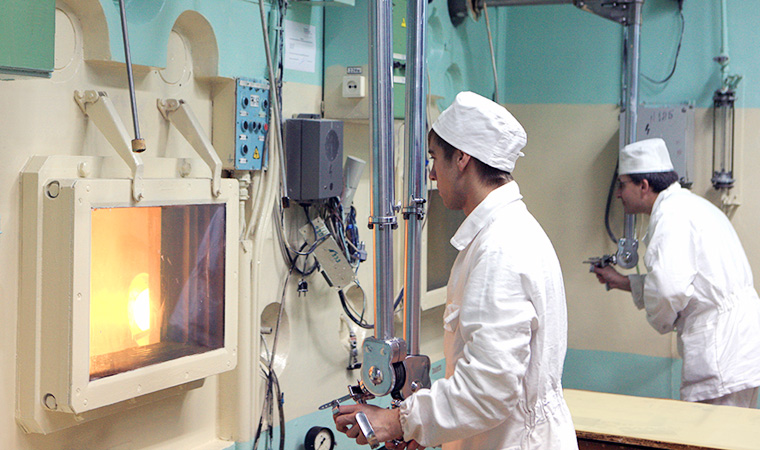
Innovations for the nuclear industry
back to contentsLast year the scientists continued to work aimed to make the Russian design NPPS better, more reliable and safe. Scientific Research Institute of Nuclear Reactors (NIIAR, the largest research experimental complex of civil nuclear power generation industry in Russia) completed the three-year program of fuel research for VVER-1000 reactors with the record burn-up of 78 MW*day/kg (U). Experiments have confirmed its working efficiency, and now Rosatom is ready to approach the international market with a product that has high technical and economic performance.
The future is already here
Although the power industry will remain based on thermal reactors for a long time, the new technological platform is under development at full speed. «For the first time in the world our institute together with PA Mayak fabricated over 100 FAs with MOX fuel for BN-800 unit», — says Sergey Pavlov, NIIAR director.
VNIINM (All-Russia Research Institute of Inorganic Materials, a part of Rosatom fuel division), the leading research institute on development of nitride fuel for future reactors, developed this year and started to irradiate the first assemblies with MOX fuel in BOR-60 research reactor. One of them has already been taken out from the core and passed post-irradiation examination in NIIAR. Other assemblies are examined in conditions of higher burn up and damaging doses. «SCC manufactured experimental assemblies on the basis of our technology for loading into BN-600, — says Valentine Ivanov, general director of Bochvar institute. – Researches are ongoing on application of hydrometallurgical methods for final processing of irradiated nitride fuel. Next large problem is pyrochemistry».
VNIIHT (Institute of Chemical Technology) also participates in development of the technology of spent nuclear fuel processing within “Breakthrough” project. “Today we are competent in the area of hydro- and pyrometallurgical processing of SNF and RAW,” underlies Andrey Yegorov, the institute director. “We will expand this direction in 2015. In particular, we plan to strengthen our competence of the area of pyrochemical processing of SNF and have already created a corresponding laboratory in VNIIHT”.
SSC RF TRINITI (Troitsk Institute for Innovative and Thermonuclear Research, the well-known in Russia and abroad centre of scientific researches in the field of controlled thermonuclear fusion, plasma physics, laser physics and technology) contributes to another scale project related to the power generation industry of the future — «IGNITOR» (esearch thermonuclear reactor with magnetic plasma confinement). «The subject of magnetic fields has always been one of the focal points in our work, — explains Vladimir Cherkovets, the institute director. – Magnetic field is one of the basic elements of modern thermonuclear facilities. People have learnt today to create very strong magnetic fields, so that the option is being considered at ТОКАМАК creation to confine using only them and the current that passes in plasma, without heating up plasma additionally using neutral beams and the electromagnetic field. We study this option in «IGNITOR» project together with Italian colleagues. Italian and Russian governments signed the agreement on performance of preliminary works, which we are now involved in together with Kurchatov institute».
Caution is the parent of safety
Rosatom needs to improve the base of research reactors to fine-tune the closed fuel cycle technologies. NIIAR was ahead of the curve last year in this area. “In 2014 we started construction of the Multifunctional radiochemical complex, where the basic elements of SNF processing technology for the fourth generation reactors will be matured,” otices Sergey Pavlov. “We obtained the license for placing new research reactor MBIR and are getting ready for the beginning of its construction”.
Research and Production Association “Luch” restores and improves the fuel fabrication technologies for research reactors within the tripartite agreement between Russia, Kazakhstan and the USA. “Luch” manufactures 32 water cooled process channels (WCPC) to modernize IVG-1M reactor core. «We manufactured 6 channels in 2014 and plan to manufacture 12 more channels in 2015, — reported Pavel Zajtsev, general director of the enterprise. Besides, one of the main achievements of the past year is the delivery to the Kazakhstan party of two experimental WCPC for IVG-1M reactor. They are about to be installed in the reactor core for testing.
Healthy technologies
Nuclear scientific research institutes achieved last year big success in the nuclear medicine. Cyclotron radiochemical complex was created on the basis of NIITFA (Scientific Research Institute for Technical Physics and Automation, involved in development of methods and equipment based on various physical principles of radiation interaction with substance). Besides the cyclotron itself this complex also includes a set of targets (target station), as well as equipment for synthesis and quality assurance of radiopharmaceutical agents for positron emission tomography. These results will allow to commence soon the batch production of equipment for PET centers based on domestic technologies: cyclotrons, radiopharmaceutical synthesis modules, protective boxes, gamma chambers and PET/CT . Rosatom Scientific and Technical Centre “Nuclear Physics Institute” (STC “Yafi”) developed electronics and software for gamma tomography detectors.
“We started in NIIAR the production operation of the second turn of Mo-99 radioisotope production and started to increase its sales both in Russia and abroad,” noted Sergey Pavlov, the institute director.
And “NIIgrafit” (the institute of graphite-based constructional materials) has worked the artificial eye to the stage of clinical studies for cosmetic restoration of a lost eyeball. “The problem of artificial eyes is that they are similar to a live eye, but are directed to one point. Our prosthesis takes to nerves and muscles of the lost eye. Cosmetic prosthesis starts to move simultaneously with the real eye; visual distinction is imperceptible,” says Yevgeny Mayanov, the institute director. Besides, due to artificial eye movement it is possible to increase the term of viability of the live eye. This is a feature of paired human organs. The same way, it is necessary to massage the healthy hand to increase blood circulation in the broken hand.”




